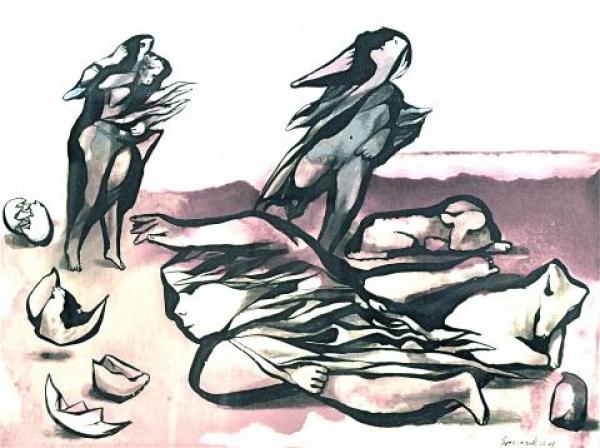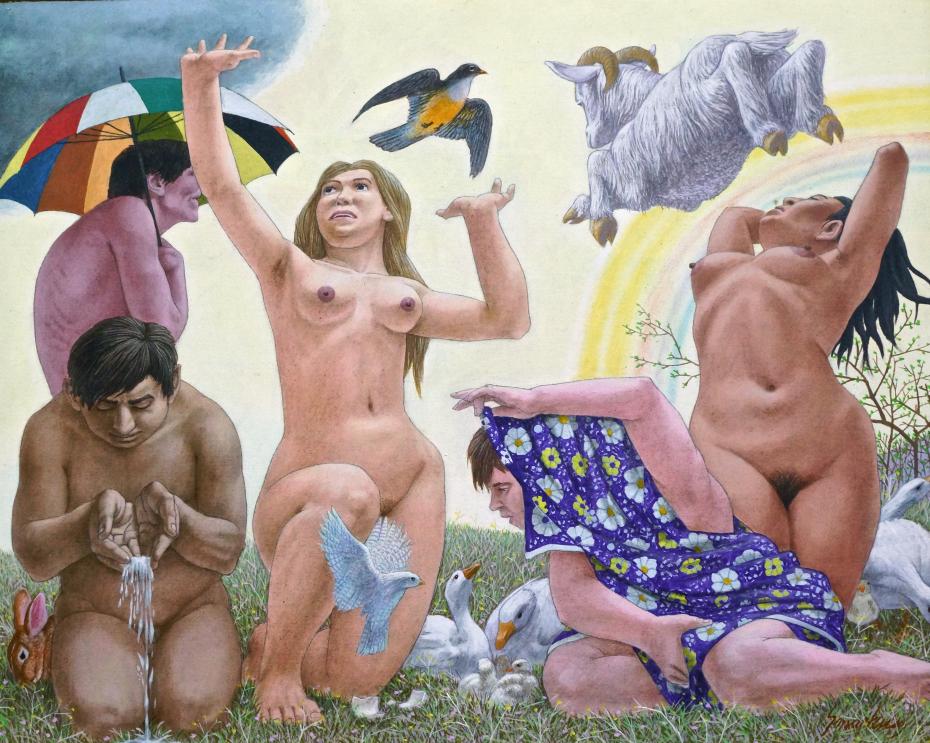April / Aphrodite / Vernal Equinox / Easter / Aries the Ram
"April" depicts the first full month of spring, as a transitional time, from the cold wet weather of March, to the sunny warm weather of May. Smarkusz also shifts his emphasis from the mysterious, spiritual and introvertive tone of his winter months, to a more natural, social and extravertive tone in the springtime and summer months of his series. Spring and summer become times of playful frolic. We will later see, when the artist depicts autumn, the mystical atmosphere begins to return, and by December, the scene is once again fully dreamlike. For now however, life reawakens in nature, and humanity emerges to explore the world.
Several Roman months were named in honor of divinities, and as April was sacred to the goddess Venus, with her Veneralia (veneration) being held on the first day, it has been suggested that April was originally her month Aphrilis, from her equivalent Greek goddess name Aphrodite (Aphros), or from the Etruscan name Apru. Others claim it comes from “aperire,” a Latin word meaning “to open”, because it represents the opening of buds and flowers in spring. A time when "fruits and flowers and animals and seas and lands do open". Aphrodite was given many names, one of which was Anadiomeni, which in Greek mean "the one who emerges."
Orphic Greek Mythology called her Aphrodite Pontogenis, meaning "born from the sea" (as was all life on Earth during it's great blossoming, or cosmic springtime phase). Traditionally, Aphrodite is depicted as being born from a cockle shell, and Venus rides onto land on a wave of seafoam. She brings the procreative urge of creation from the great oceanic beyond to the natural realm. In another tradition, Aphrodite is born from a dove’s egg that falls from heaven, thus also representing the creative force as coming down from above. Rain first fell to earth and gathered into fertile oceans, which produced life that was delivered onto the land.
Smarkusz represents these vernal goddesses as voluptuous and fertile women. The golden haired beauty appears to be welcoming the gentle life giving rains with one hand, while releasing the "first robin of spring" from the other. The bird flies in the direction of time as the month progresses from rainy to sunny. She is on one knee, transitional from standing to sitting, as she transfers her fertile energy from the sky to the ground - from the heavens to nature. At her knee is the shell from which a white dove is emerging, further reinforcing the connection to Aphrodite as "the one who emerges" (See "Birth of Aphrodite" by Smarkusz below). The other woman, a buxomy brunette, is the more sensual of the two, suggestive of the spring rites of courtship, young love and sex. She is enjoying the warming rays of the late April sun.
Meanwhile, a white ram which symbolizes new beginnings, "springs" into action and is leaping over her in the arc of a rainbow, signafying an end to April's showers. The also ram represents masculine energy, which is coupled with the feminine energy of the goddess below him - as male and female symbols of fertility. Aries the Ram is also a masculine fire sign in the Zodiac - representing the increasing sun......
Fertility is also symbolized by the man running water through his hands and in front of his genitals. He represents the male element of creation through fertilization, as the "waters" of life flow through him and into mother earth. To his left, as if created from the white water that falls from his hands, a white bird rises up from the earth (as the spirit of life). Behind him and to his right, the spring hare is also a traditional symbol of fertility and fecundity. The white dove is also symbolic of the resurrection of Christ, which is another version of the Perennial Philosophy of rebirth - and represents Easter as the holiest of Christian holidays. Bunnies and hatchling ducks are also asssociated with the holiday, as are eggs in general. This arrangement is another of Vincent's associations of sexuality with spirituaty, a common theme in much of his work.
"April showers bring May flowers" is represented by the boy emerging from his winter rest to greet the new season. Or he is shielding himself with his picnic blanket from the occasional sun-shower that falls at this special time of year, creating rainbows! Either way, he is looking at the white dove emerging from its shell, in wonderment of the bright new season. It may also be the artist himself representing his emerging consciuosness in springtime after being born at the end of winter (Feb.18) - or signaling to us his interest in the divine qualities of nature. Vincent often includes himself in his scenes, usually as an innocent young boy, and hints at this fact by signing his name nearby.
To further illustrate the transitional quality of April weather, I submit this excerpt from "Two Tramps in Mud Time" (no pun intended - although V would have appreciated it) by Robert Frost:
The sun was warm but the wind was chill.
You know how it is with an April day
When the sun is out and the wind is still,
You're one month on in the middle of May.
But if you so much as dare to speak,
A cloud comes over the sunlit arch,
A wind comes off a frozen peak,
And you're two months back in the middle of March.
For those interested in Vincent's symbolic style of composition, the following analysis is offered:

To be continued.....

"The Birth of Aphrodite" by Vincent Smarkusz
BACK to The Mancent Collection gallery

